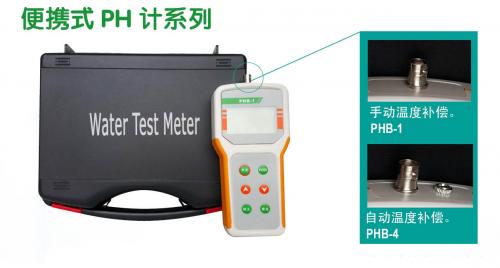out of the acceptance
please check the following devices after the instrument is unpacked:
1. portable ph meter host 1
2. composite electrode 018 temperature electrode 1 branch
3. short circuit plug (which has been inserted on the electrode socket at the back of the instrument
four dc1.5v batteries
5. standard buffer reagents: 1 set of ph4, ph6.86 and ph9.18
6. one manual
7. one copy of warranty card
8. one copy of product qualification certificate
2. technical characteristics and operating conditions of the instrument
measurement range :ph: 0 ~ 14.00ph; mv: & plusmn; 1600 mv,
temperature: 0 ~ 60 ℃
resolution :ph: 0.01ph
temperature: & plusmn; 1 ℃
precision :ph: 0.01ph, temperature: ± 1 ℃
automatic temperature compensation: 0-60 ℃ temperature compensation/manual compensation
basic configuration: e201-c plastic shell ph composite electrode; ph calibration specimen; four dc1.5v batteries
the working conditions
when the environment temperature degrees: 0 ~ 40 ℃ relative humidity: < 85%
power supply: 1.5v battery /4 knots
has no noticeable vibrations
there is no interference from external magnetic fields except earth's
input impedance: ≥ 1 & times; 1012 & omega;
zero drift: ≤ 0.01 ph± 1 word / 2 hours
low solution temperature compensation scope: 0 ~ 60 ℃
appearance size and weight: 180× 80 & times; 30 mm (long & times; wide & times; high) 0.5 kg
consumption power: 2 w
iii. working principle of the instrument
basic principle of ph measurement
the ph value of aqueous solution is generally measured by using glass electrode as the indicator electrode and calomel electrode as the reference electrode. when the hydrogen ion concentration (strictly speaking, activity) in the solution, i.e. the ph value of the solution changes, the electric potential between the glass electrode and the calomel electrode also changes, and the relation of electric potential changes conforms to the following formula:
delta e = 58.16 & times; delta ph× (273 ℃) t / 293 (mv)
sector e: represents a change in potential in millivolts. (mv)
flowering ph: represents the change in the ph of the solution.
t: it means the temperature of the test solution (℃).
the commonly used indicating electrodes include glass electrode, antimony electrode, fluorine electrode, silver electrode and so on, among which glass electrode is the most widely used. the head of ph glass electrode is made of a special sensitive membrane, which is sensitive to hydrogen ions. when it is inserted into the solution under test, its potential changes with the concentration and temperature of hydrogen ions in the solution under test. changes in solution temperature is 25 ℃, every 1 ph, electrode potential change 59.16 mv. this is the theoretical slope coefficient of the electrode.
the potential of the commonly used reference electrode is not changed with the concentration of hydrogen ions in the tested solution.
the essence of ph measurement is to measure the potential difference between two electrodes. when the potential difference between a pair of electrodes in the solution is equal to zero, the ph value of the solution under test is equal to zero potential ph value, which is related to the solution inside the glass electrode. this instrument is equipped with a composite electrode, which is composed of glass electrode and ag-agcl electrode. its zero-point ph value is 7±. ph 0.25.
iv. method of instrument use
reserve
open the instrument at the back of the battery cover, fitted with a 1.5 v battery section 4 (note the positive and negative). remove the short circuit plug on the instrument electrode socket and plug in the electrode. pay attention to the electrode plug before use should be clean and dry, do not be contaminated.
according to the power supply is connected to open the key, preheat for about 5 minutes
